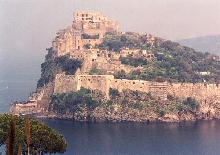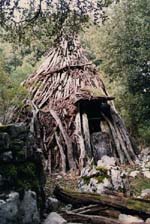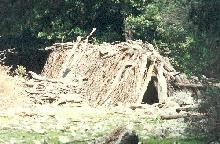
In order to better understand the Mediterranean, which literally means “the centre of the world”, it is useful to know some of its long and varied history.
Geography
The Mediterranean was once a deep, dry valley, some five million years ago, dividing the three continents, Europe, Africa and Asia, until a cataclysmic broach was made in the retaining wall, which kept out the Atlantic Ocean in the West, towards present-day Gibraltar. A huge cascade of water began, flooding the whole Mediterranean basin, in a process that lasted many, many years, and a new sea was born.
Analysing the geographical configuration of this new sea more closely, we find that it is rather formed from a number of seas: the Alboran, the gulf of Lione, the Tirrhennian Sea, the Ionian Sea, the Aegean Sea, the Adriatic Sea etc, each with its own characteristics. On the whole it is a very deep sea, from 3000 to 4000 metres deep, allowing several types of whales to thrive there, as well as sword-fish, tuna and dolphins, which are often encountered by modern yachts during their cruises.
The Mediterranean is a relatively closed sea, with only a slight interchange of waters with the Atlantic at the Straits of Gibraltar and with the Black Sea at the Bosphorous Straits, at Istanbul. The Suez Canal at the far Eastern end, provides only an artificial, though navigable connection with the Red Sea. The African and the Asian shores are very arid and flat, while the European shores, though not subject to a heavy rainfall, are more mountainous and greener, with a more temperate climate.
Since the African Continent has been slowly pushing its way towards the European Continent, and this has been the cause of the uplift of the Alps, there is a fracture in the Earth’s crust, resulting in the volcanoes of Etna, Stromboli and Vesuvius in Italy and Santorino in Greece. It is also the cause of the not uncommon seismic activity in the area.
The general climate is mild and temperate, in fact called “Mediterranean” and it is influenced by the hot and dry air coming from the Sahara in Summer, making for idyllic holidays and from the damper and colder air from the Atlantic Ocean in Winter. This type of climate was in fact very suitable for the development of Man’s civilisation.The arrival of man
Man arrived on the scene very late in the Mediterranean’s history, with traces of Neanderthal Man in the caves at Circeo, just south of Rome, in the Ligurian coast of Italy, in Gibraltar, in France and in some other areas. The arrival of our more direct ancestor, Homo Sapiens, can be traced to around 100,000 years ago. Knowing his propensity for war right up to the present day, one can legitimally suspect that Homo Sapiens Sapiens actually had a hand in the extinction of Neanderthal Man about 30,000 year ago.
Each recurring ice-age produced huge drops in the level of the seas, as much water was deposited miles high, in the form of ice in the world’s polar regions. This allowed primitive man to wander ever further and to populate many lands, even those which were later to become islands, with the return of higher sea levels during the warmer ages. For example, Sardinia was populated in this way, some 40,000 years ago, by wandering tribes coming from Tuscany, through Elba into Corsica and across into Sardinia.
With the return of a higher sea level, these first Sardinian tribes became stranded there and remained isolated for a very long period, until visitors arrived by boat very much later. Today the Sardinian people represent a uniquely different population from that of the rest of Europe, remaining a relatively "pure" example of the Indo-European tribes wandering around Europe 40,000 years ago. A similar example is the Basque population, isolated in the Pyrinees mountains between Spain and France.
Primitive huts still used in Sardinia
Primitive Man was not to be stopped for very long by short stretches of water, as his innate curiosity and thirst for adventure, drove him on rudimentary rafts and boats made of bundles of reeds, to paddle and drift his way across waters, to islands such as Cyprus and Malta 5000 years ago, where they formed the basis of present day populations. Man slowly populated the whole Mediterranean basin and thrived successfully in this favourable and special environment.
The Mediterranean now represents the cross-roads of Western Humanity, with layer upon layer of different cultures; for example you will find Roman cities all over the Mediterranean, Greek cities in Sicily, the Arabs in Spain, Islam in Yugoslavia, making a fascinating mixture that will enthral the sailor-tourist on his travels around the MediterraneanAgriculture
At the time when mammoths still roamed the heavily forested countryside, Europe was sparsely populated by nomadic tribes who lived mainly on hunting and gathering of available food in the form of fruits, berries and grains. They began to graze their newly domesticated animals and discovered the possibility of planting the seeds of the precious grain-bearing plants around 9000 years ago, probably at first in the Kurdistan area of Turkey. They lived on the higher shores of the Mediterranean, more suited to their needs, permitting a more abundant and more efficient production of food, which allowed man to prosper and to grow in number.
It was soon found necessary to descend to the more fertile plains, where larger fields were available for sowing the precious grain, which was ever more vital to feed the larger populations that were gathering in the permanent settlements, that were soon to grow into towns and later into cities.
Those who chose to remain on the higher ground had to continually battle against nature, to eke out a living, by laboriously constructing over the centuries, those terraced plots on the steep hill-sides, which are a picturesque feature of the Mediterranean landscape. There was also a strategic plan in remaining on the more inaccessible slopes: to better escape the ravaging marauders, which were an all too often occurrence along the Mediterranean coastlines. This is also the reason for the lovely hill-top towns we see today, girthed by their massive walls and many defensive towers.The Egyptians
The twice annual flooding of the enormous Nile delta, was considered a god-sent gift by the Egyptians, as it brought precious water and nourishing lime to the plains, that guaranteed them a rich harvest. These people flourished under this constant supply of food and their civilisation grew and prospered and developed into one of the most long-lasting civilisations of the Mediterranean, for fully 3000 years, commencing 5000 years ago. They developed an illustrative form of writing, called hieroglyphics and worshiped many gods, which gave them a certainty in the after-life. In fact the construction of the pyramids, served to protect the mummified bodies and the preserved utensils, that would be needed in the after-life.
The constant winds blowing up-stream, favoured the Egyptians in extending their influence up the Nile River, rather than out into the Mediterranean sea, or along its arid shores. They would also certainly have found that their flat-bottomed river-boats were most unsuitable for navigation in the sea.
The Mesopotamians
The City-State civilisations that developed in Mesopotamia, were the Sumerians (their capital Ur), the Babylonians (Babylon) and the Assirians (Nineveh). They invented a cuneiform type of writing on clay tablets and prospered from 3000 BC, to 550 BC. Their dedication to astronomy gave us the present names of the days of the week. The hanging gardens of Babylon were one of the seven wonders of the ancient world.
Successively, the nearby Persians in central Iran, from their capital Persepolis, began to spread their influence to the whole area. With their abundant wares and foods, the Persians commerced both down-river towards the Indian Ocean and across the desert to the shores of the Mediterranean, where they encountered the Phoenicians. They ruled an empire including all of Mesopotamia, Syria, Egypt and parts of Asia Minor and even attacked the Greeks, but with little success, until they finally encountered their downfall with Alexander the Great in 331 BC.
The Palestinians
Palestine, situated on the Mediterranean coast, was a land of shepherds, the Hebrews, who preached only one god, when all peoples so far worshiped many gods. Abraham and Moses, were two of their more noted leaders, at around 1000 BC. This small area was to give birth to three main religions, Hebrew, Christianity and Islam, that were to have three billion followers throughout the world. The city of Jerusalem was to be contested by each religion as its own capital and this has ever since been the cause of conflict, right up to the present day.


No comments:
Post a Comment